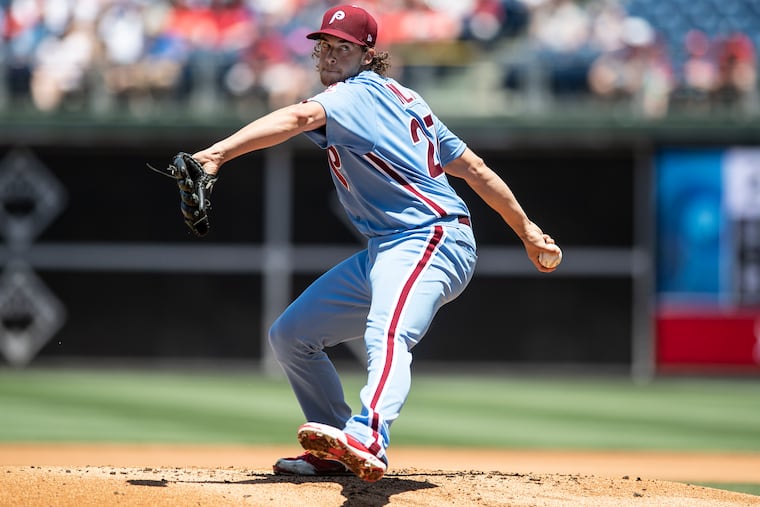While much of the Phillies’ pitching staff flounders, Aaron Nola is back to his 2018-level dominance
After struggling earlier in the season, the 26-year-old ace is in the midst of one of the best three-start stretches in franchise history. The Phillies only wish he could pitch every day.

NEW YORK — For the better part of three months, armchair pitching coaches and actual ones went in search of reasons to explain why Phillies ace Aaron Nola wasn't dominating hitters in the way that he did last season.
A few popular theories:
— Nola was coping with the residual effect of pitching 212 innings last season, a 26-percent increase from his previous career-high in 2017.
— Amid whispers that baseballs are being rubbed up with a different type of mud than in past years, Nola was having difficulty finding his usual grip, particularly of his curveball.
— Nola insisted all along that he was healthy, but perhaps a minor physical issue, one that he was able to pitch through, was causing a spike in his both home-run and walk rates.
"We studied all that stuff," Phillies pitching coach Chris Young said the other day. "Our whole group was looking at him on an every-start basis, on a daily basis."
As usual, the answer was much more subtle. A tweak to his delivery here, a touch to his mechanics there, and Nola is in the midst of the best three-start stretch of his career entering Sunday’s first-half finale against the Mets at Citi Field.
That isn't hyperbole, either. Beginning with his June 21 start at home against the Miami Marlins, Nola has allowed one earned run on 11 hits in his last 23 innings. He has struck out 28 batters, walked only five, and allowed just one home run, no small achievement given the collective struggles of Phillies pitchers to keep the ball in the yard.
To put Nola’s roll into context, consider this: The only Phillies pitchers ever to string together back-to-back-to-back starts of at least seven innings and eight strikeouts with no more than one earned run allowed are a who’s who of the best pitchers in franchise history — Grover Cleveland Alexander (1911), Steve Carlton (1972, 1980, and 1982), Curt Schilling (1998), Randy Wolf (2001), Cliff Lee (2009), Roy Halladay (2010), Cole Hamels (2014), and Nola (2018, 2019).
And if you doubted that Nola would eventually come around this season, well, he didn’t.
“There’s always going to be ups and downs,” Nola said Wednesday, one day after stymieing the division-leading Braves for eight innings. “I had some ups and downs. I had some struggles for a while. It’s tough. But I always believe that it’s going to turn around. I don’t know when, but I always believe that it will. It’s not going to be cruise control all the time, as much as I would like it to be.”
But Nola’s struggles through the middle of June were profound. He gave up at least five runs in four of his first 15 starts. He averaged four walks and 1.4 homers per nine innings, well above his career averages of 2.6 walks and 0.9 homers per nine innings. After getting knocked out after 4 1/3 innings in a June 15 dud in Atlanta, he had a 4.89 ERA that was second-worst among NL pitchers who had worked at least 75 innings.
Among the most glaring issues was the ineffectiveness of Nola’s curveball, normally his biggest weapon. Earlier in the season, he shrugged off the suggestion that the suspected change in the way the balls were being prepared was causing him problems, but Young at least allowed for that possibility.
“If you wrote every year for 10 years in a row with a No. 2 pencil and somebody handed you a No. 1 pencil," Young said, “you’d probably feel the difference right away.”
But while Nola’s curveball has returned in a big way, he’s convinced that his biggest problem was being able to command his fastball. Lately he’s been getting ahead in the count more consistently with his heater, which has enabled him to put hitters away with other pitches.
“My fastball command is better, which opens my curveball up,” Nola said. “I really try not to pitch off my curveball. I always try to pitch off my fastball.”
It wasn’t any dramatic moment that led to Nola’s resurgence. Instead, he said it was a minor adjustment in how he released the ball.
And if any pitcher was going to be able to make that fix, Young knew it would be Nola.
“I think as a group none of us was really concerned about Aaron Nola,” Young said. “The work ethic’s there, the dedication’s there. He spends more time at the computer studying himself. He knows himself better than any of us know him.”
Besides, the Phillies’ rotation problems are too big to worry about their ace. After wagering that their holdovers were better than the free-agent options such as Charlie Morton, Lance Lynn, and Dallas Keuchel, Nick Pivetta and Vince Velasquez were removed from the rotation earlier in the season and Zach Eflin has faltered badly after pitching well for two months.
Meanwhile, the offense isn’t scoring as many runs and the bullpen is banged up. More than ever, the Phillies must lean on their ace. So after taking every previous opportunity to give Nola additional rest, manager Gabe Kapler and Young used a day off last Monday to squeeze one more start from him before the All-Star break.
“I was excited they switched the rotation up a little bit so I can get one extra start," Nola said. "I want to get out there as much as I can and give us an opportunity to win.”
Especially when he’s on a roll like this.